Train & Hope??
![]() Training is necessary but often insufficient to ensure adoption of new practices.
Training is necessary but often insufficient to ensure adoption of new practices.
White elephant
![]() Create effective, sustainable programs before sinking money into a new building.
Create effective, sustainable programs before sinking money into a new building.
Implement, baby, implement
![]() Is traditional autism research becoming a bridge to nowhere?
Is traditional autism research becoming a bridge to nowhere?
Research to guide services
AutismSpectrumNewsNot all research is equally relevant to those focused on providing services.
A Network on Excellence
 Can statewide training increase expertise and capacity, and bridge gaps?
Can statewide training increase expertise and capacity, and bridge gaps?
A Bus to Betsy's
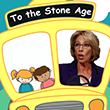 The nominee to lead special education in the US could send it back to the Stone Age.
The nominee to lead special education in the US could send it back to the Stone Age.
The Business of innovation
 New services are shaped not by research but by available funds, staff, and expertise.
New services are shaped not by research but by available funds, staff, and expertise.
Margot votes! Will others?
 Learn how people like Margot exercise their right to vote in the 11 states that allow it .
Learn how people like Margot exercise their right to vote in the 11 states that allow it .
CoVid's silver lining
 Insights into the isolation and costs of disability might finally spur policy changes.
Insights into the isolation and costs of disability might finally spur policy changes.
A State of Synchro
The magic of teaching someone like Margot to ski mobilizes a remarkable army.
A Drop in the Bucket
New data suggests ASD research has little impact on improving identification.
 CoVid: A Tornado with a silver lining
CoVid: A Tornado with a silver lining
CoVid can help others begin to understand the challenges of living with I/DD, and perhaps finally push us towards new partnerships between parents, schools, and community programs
August 25, 2020
A health crisis has kept people like my daughter out of school and work, effectively imprisoning us in our own homes. Isolated from friends and extended family, and prevented from venturing out into the community, families like ours have really struggled to stay hopeful. Unforeseen expenses and the loss of work have hit our pocketbooks hard, and the impact of having a career put on hold will be felt for years to come. All of these effects are magnified for families of color and those living in poverty.
Scientific research has identified specific gaps in treatment and services, but there appears to be little appetite for the kind of policy changes needed. Why? Most people are completely unaware of the scope of this crisis, unless it has touched someone in their own family. For families affected, their lives are changed forever.
This tale is not about CoVid. It is about significant intellectual and developmental disability (I/DD), and its impact on children and their families. For these families, the crisis did not just begin several months ago. It began the day their child was diagnosed. For some, it began the day they were born. For most families, it ebbs and flows, re surging at key transitions in care and schooling: for others, it is an almost constant crisis.
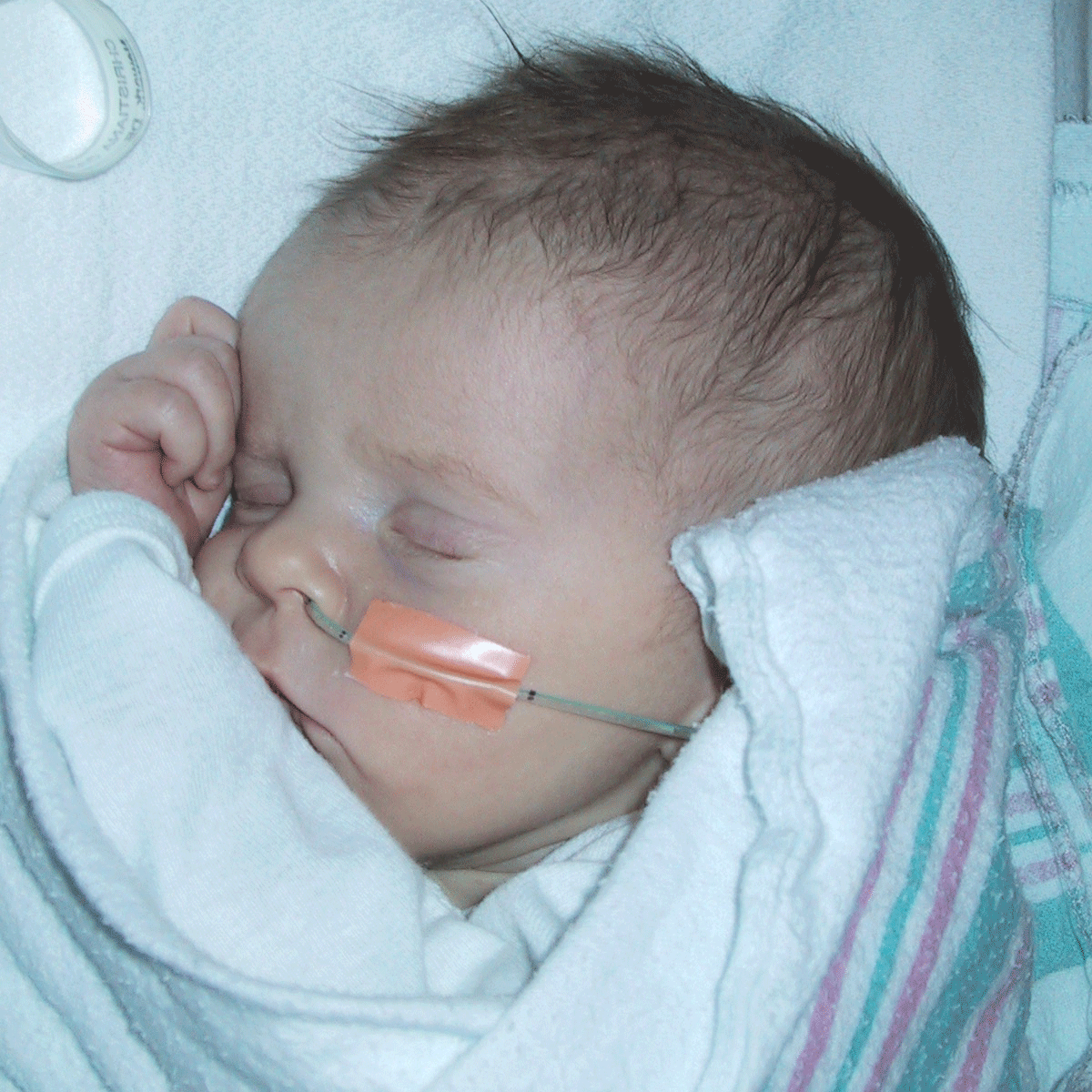 The depth of this crisis is difficult to fathom unless you have lived it. I designed and delivered programs of services to children with Autism Spectrum Disorder (ASD) and their families for 8 years, without knowing that I never really understood what these families were experiencing. The day my Margot was born almost 20 years ago and then placed immediately into intensive care, I finally started to get it.
The depth of this crisis is difficult to fathom unless you have lived it. I designed and delivered programs of services to children with Autism Spectrum Disorder (ASD) and their families for 8 years, without knowing that I never really understood what these families were experiencing. The day my Margot was born almost 20 years ago and then placed immediately into intensive care, I finally started to get it.
Maybe CoVid can now help others get it too. How? Many of CoVid’s extraordinary hardships are ones that have become quite ordinary for us. Other families now experiencing these same hardships can gain new insights into the impact of I/DD, and perhaps can join us in mobilizing for long-overdue policy changes. I sure hope so, because families who have weathered I/DD’s storms for years now face hurricane-force headwinds under CoVid, in part because of decisions being made by governments and schools across the country, right now.
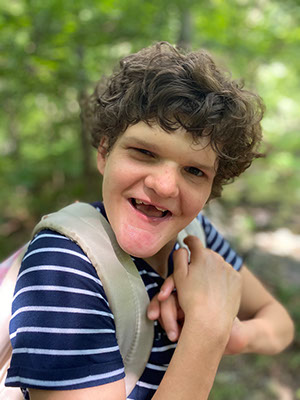 Is this portrayal too dramatic? After all, Margot is not a hurricane but a young woman eager to greet you with a “Hah” and her signature lopsided smile and honey curls, whether on a trail or a river or a ski slope. My wife and I do not look like the exhausted survivors of a terrible storm, nor are we heroes for trying to give Margot a good life. We have just done what every parent would do for their own child. And we are so very fortunate to afford full-time help to manage Margot’s complex developmental and medical needs. If we appear to press our case too hard, it is because of the many other families - especially those with limited resources - who are too exhausted to press theirs.
Is this portrayal too dramatic? After all, Margot is not a hurricane but a young woman eager to greet you with a “Hah” and her signature lopsided smile and honey curls, whether on a trail or a river or a ski slope. My wife and I do not look like the exhausted survivors of a terrible storm, nor are we heroes for trying to give Margot a good life. We have just done what every parent would do for their own child. And we are so very fortunate to afford full-time help to manage Margot’s complex developmental and medical needs. If we appear to press our case too hard, it is because of the many other families - especially those with limited resources - who are too exhausted to press theirs.
Parallel impacts and shared gifts
CoVid and I/DD might not seem similar: CoVid is a disease that strikes quickly. leading to hospitalization even in some healthy people, and death for those who are older and who have other health conditions. Once recovered, some will struggle with after-effects, but many can return to their normal lives. I/DD is a condition present at birth that often requires different forms of medical care but rarely leads directly to death. There is no prospect of “recovery”, but a lifetime commitment to learning skills that many others take for granted.
But people with CoVid and with I/DD are the same: they want to be happy and healthy, to do work that is valued and fulfilling, to be connected with their community, and to love and be loved. They did nothing wrong: their luck just failed them when God rolled the dice. And the hidden costs and the unexpected joys are remarkably similar, except that the impact of I/DD is often even more broad and more sustained than CoVid.
There are many other parallels, like in unemployment. While April’s unemployment rate of 15% under CoVid is unprecedented in the modern era, such an unemployment rate would be celebrated by people with I/DD. Less than one half of working age adults with I/DD are in the workforce, and more than one-quarter have never held a job. The type of work and the salaries possible are extremely limited. For many people with I/DD, breaking through the poverty line is as likely as busting Barry Bond’s single season home run record.
 A significant impact is also felt by parents. Many forgo opportunities for advancement or reduce their hours or leave the workforce altogether. I tried a regular job for 12 years after Margot was born - at times shuttling straight from her hospital bedside overnight to my office in the morning. I finally accepted a cut to my pay (and to my ambitions) to work from home, and it has been worth it! Finally, I had the time I needed to address long-standing gaps in her care created because agencies forgot - or sometimes outright refused - to talk to another. Like the behavioral health agency and the hospital that would never have coordinated plans that parallel those developed at school, had I not insisted that we all meet and review these. Even better, are the many new experiences Margot and I now cherish together, like biking, hiking, skiing, kayaking, and camping. She has blossomed!
A significant impact is also felt by parents. Many forgo opportunities for advancement or reduce their hours or leave the workforce altogether. I tried a regular job for 12 years after Margot was born - at times shuttling straight from her hospital bedside overnight to my office in the morning. I finally accepted a cut to my pay (and to my ambitions) to work from home, and it has been worth it! Finally, I had the time I needed to address long-standing gaps in her care created because agencies forgot - or sometimes outright refused - to talk to another. Like the behavioral health agency and the hospital that would never have coordinated plans that parallel those developed at school, had I not insisted that we all meet and review these. Even better, are the many new experiences Margot and I now cherish together, like biking, hiking, skiing, kayaking, and camping. She has blossomed!
There are other parallels in CoVid's quarantine. Some families of children with I/DD live in a kind of quarantine most of their lives. We cannot go anywhere - to the gym or library or restaurant - unless we leave Margot in someone else’s care. The only relaxing “adult” time we can really spend with friends is when they come to our house once Margot is in bed. Margot has no social life outside of school and family.
And there are still more parallel gaps in childcare. Children with I/DD are almost always underfoot when they are not in school; access to after-school care, summer camps, and weekend sports is limited for many children and impossible for some. Margot requires constant supervision from ourselves or her absolutely devoted caregiver unless she is sleeping or in school.
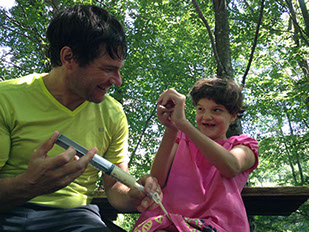 Bolus feed in the Lehigh GorgeParallel challenges also exist with respect to accessing healthcare. Children with I/DD are more likely to have significant, co-occurring problems with physical and mental health, but finding a primary health or dental care provider able to accommodate their special needs can be impossible. It took us 5 appointments with 3 different providers resulting in 5 days of missed work over 4 months to get a dental checkup and cleaning. And you cannot always count on getting of the guidance you need from specialists. Had we not taken the initiative to move her to bolus feeding, and then from Pediasure to a completely natural diet, Margot may still be tethered to a pump 2-3 hours a day and struggling with chronic constipation. Now she eats a healthier diet than we do!
Bolus feed in the Lehigh GorgeParallel challenges also exist with respect to accessing healthcare. Children with I/DD are more likely to have significant, co-occurring problems with physical and mental health, but finding a primary health or dental care provider able to accommodate their special needs can be impossible. It took us 5 appointments with 3 different providers resulting in 5 days of missed work over 4 months to get a dental checkup and cleaning. And you cannot always count on getting of the guidance you need from specialists. Had we not taken the initiative to move her to bolus feeding, and then from Pediasure to a completely natural diet, Margot may still be tethered to a pump 2-3 hours a day and struggling with chronic constipation. Now she eats a healthier diet than we do!
And everyone can relate to parallels in terms of costs. The income lost from changes to your work is just the start. Try multiplying the costs of after-school care, babysitting, or summer camp for your typical 5 year old by a factor of 3, plan on paying it for your entire life, and then be thankful if you can even find a competent provider. And be prepared to pay out of pocket to close other gaps in services or entitlements. While insurance and physicians argued over what Margot needed, we paid $1000 out-of-pocket for one month of seizure medication, and bought nutritional supplements off of EBay for a year. All this adds up to thousands if not tens of thousands in annual costs for each family.
I could go on and on and on, especially about some of the ways I/DD’s impact diverges from CoVids...There are the really big, lifelong concerns, like the very real risk that behavioral and/or mental health problems become unmanageable and require long-term institutionalization. Or the nagging worry about who will care for your child once you are gone. There are the daily hassles, like trying just to get primary medical and dental care, or picking up groceries with a 19 year-old who could either throw a toddler tantrum or merely offend some unsuspecting customers (this week Margot chose the latter, with friendly taps to the behinds of 5 passers-by in 5 minutes).
But you are unlikely to ever hear anyone like me go on and on (and on) about the challenges of I/DD or CoVid. Why? Misery is a dish best eaten alone (unless you wish to poison your guests). And besides, there is always someone else who faces challenges far greater than yours. So whether challenged by I/DD or CoVid, we learn to quietly soldier on, looking again for help and hope. And we find both.
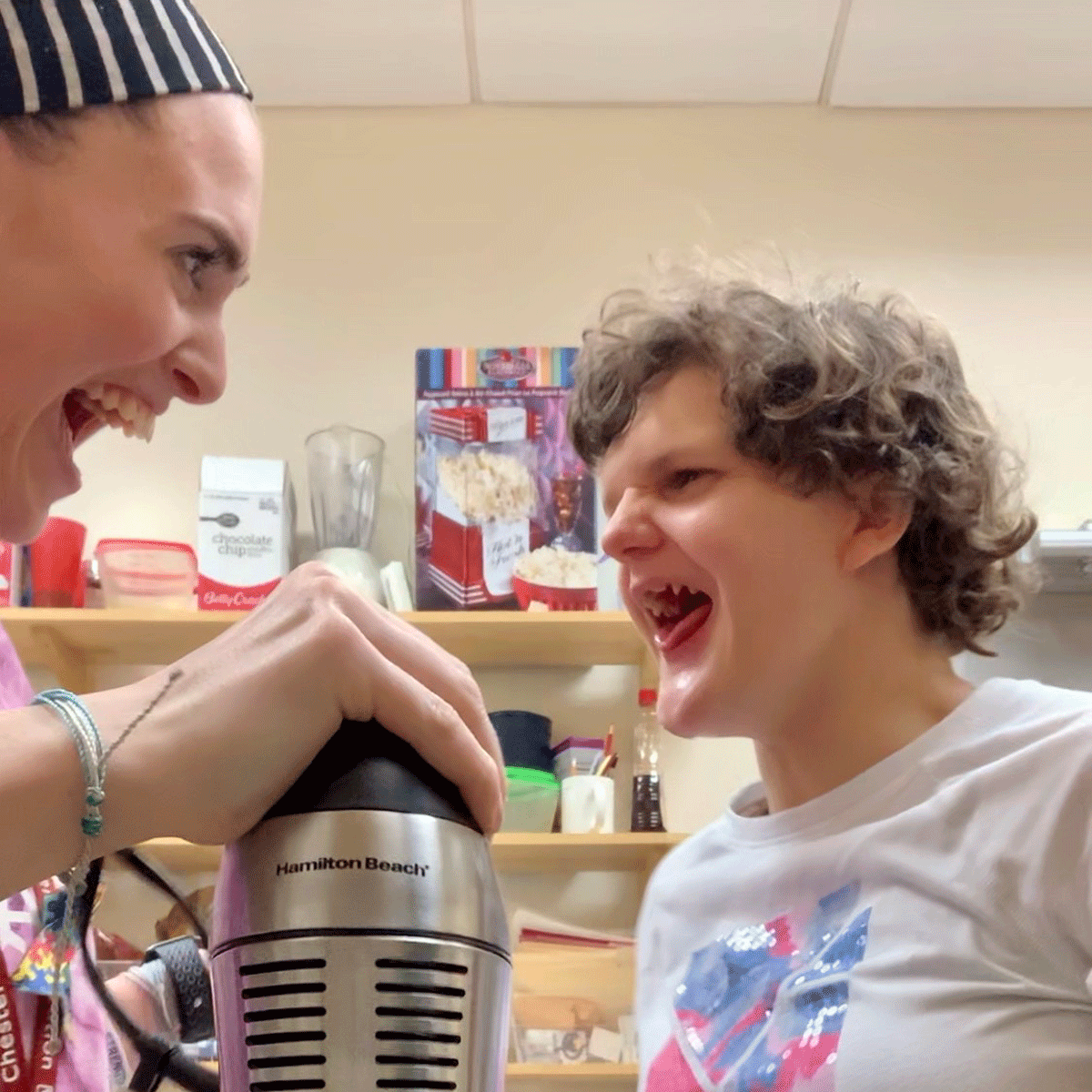 With one of many amazing aides!Like in essential workers. While CoVid has brought long-overdue recognition for this dedicated army, many families of children with I/DD have known for years just how special special educators can be. We marvel at teachers, assistants, and other professionals who treat our children like they are their own, and who remain devoted despite limited staffing and resources, working in overcrowded (and sometimes ancient) buildings, and laboring up a paperwork mountain worthy of Sisyphus.
With one of many amazing aides!Like in essential workers. While CoVid has brought long-overdue recognition for this dedicated army, many families of children with I/DD have known for years just how special special educators can be. We marvel at teachers, assistants, and other professionals who treat our children like they are their own, and who remain devoted despite limited staffing and resources, working in overcrowded (and sometimes ancient) buildings, and laboring up a paperwork mountain worthy of Sisyphus.
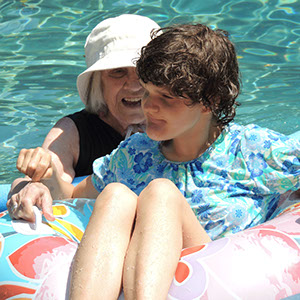 With GrandmaLike in those family members and true friends who have begun to recognize our struggles and who appreciate how special Margot is. Both CoVid and I/DD compel friends and families to learn new ways to re-connect, support, and strengthen one another. Discovering the depth of my own mother’s love and devotion to Margot is a gift I will cherish forever. So are the gifts of other friends and family who greet Margot first, inquire eagerly about her progress, ask how best to accommodate her needs, and then join us on hikes and bike rides.
With GrandmaLike in those family members and true friends who have begun to recognize our struggles and who appreciate how special Margot is. Both CoVid and I/DD compel friends and families to learn new ways to re-connect, support, and strengthen one another. Discovering the depth of my own mother’s love and devotion to Margot is a gift I will cherish forever. So are the gifts of other friends and family who greet Margot first, inquire eagerly about her progress, ask how best to accommodate her needs, and then join us on hikes and bike rides.
Like those souls sworn not just to survive these hardships but to grow through them. They help us make meaning of the mess of I/DD or CoVid. Margot is one of those souls. Her gait might be slow and unsteady, she might not understand what is happening next, and she might not be able to tell us what she needs or where it hurts. She does not cry when she tips over on her skis or into the river, but tells us through her laughter that she wants to try again. She is brilliant!
The collision of CoVid and I/DD
While the challenges that CoVid and I/DD each create are daunting, their combination is horrifying, like the collision of two ships in the dead of the night. Without routines disrupted and without support for parents, problem behaviors like aggression and self-injury begin to spiral into crisis. The slow-motion shipwreck of a behavioral crisis was the nightmare I feared as a school leader responsible for the education of a thousand children with ASD. This was a nightmare I first lived when the only program willing to accept a young man in my care relied on electric shocks to control his violent outbursts. And this was a nightmare I later sought to prevent by launching and leading a specialized in-patient treatment program for children with ASD in intense behavioral crisis. And my nightmare pales in comparison to that experienced by the person and the family, when the resolution of this crisis includes a residential placement outside of the family, in a group home or other setting, often for the rest of the person's life.
Families like ours have already survived one shipwreck; we know to cling to the wreckage, to learn to swim with our child, to scan the horizon for help, and to search for beauty in a rising sun. But now we must do more: we also make sure to steer clear of the next collision, and be ready to plug the holes in our policies and programs.
The good news is that these kinds of collisions are entirely preventable. The lessons learned from the best available research have become clear: we have effective evidence-based practices to prevent these crises, and just need to develop and invest in programs to deliver them effectively. Implementing these programs is the smart thing to do. It is the right thing to do.
The collision of CoVid, I/DD, and special education.
At the moment I write this essay,some children like Margot have been out of school for 5 months, with still no clear end in sight. Many of these children are unlikely to directly benefit in any meaningful way from remote learning because of what they need to learn and how they need to learn it. Under any other circumstance, the Individuals with Disabilities Education Act (IDEA) would require schools to plan ongoing adaptations to ensure that children like Margot continue to make reasonable progress. And if they cannot, then schools plan on making up for this lost time through what is called compensatory education (comp-ed).
Without clear guidance from the federal government on these rights, states have buried their heads in the sand, followed quickly by school districts already overwhelmed by CoVid. I suspect that many school districts will, like ours, hesitate to make any reasonable commitment to compensatory education. They will continue to promote the benefits of virtual instruction, despite the lack of evidence of direct benefit to the student, and despite the additional burdens this places on parents whose children require constant prompting to stay on task. The failure to openly discuss compensatory education, or to discuss other options for delivering instruction, effectively strips children like Margot of their legal and their civil rights, at a time when their parents are already overwhelmed with CoVid. Will thousands of parents left adrift have no choice but to spend thousands of dollars each to initiate thousands of lawsuits across the country, all addressing the same questions?
Even with clear guidance, schools cannot design and deliver the education required without a significant infusion of support from Congress. If Congress can give billions to businesses without caring how many millions line the pockets of CEOs, Congress can give billions to schools to give millions of students with I/DD the education the law clearly entitles them to.
Even with significant infusions of new funding (like those proposed by Vice President Biden), many schools simply lack the capacity to train existing staff, bring in new staff, or make other changes needed. Consider comp-ed intended to make up for lost hours... How do you deliver one or three or five months of comp-ed through traditional mechanisms, once schools re-open? There are only so many days in a week, and weeks in a year. And so we remain adrift, now entering a new school year with the prospect of hundreds more hours of education lost in those districts that rely solely on online education options.
New partnerships, new possibilities
There is reason for optimism. The lessons we have since learned from the best available research have become clear: we have evidence-based practices to teach new skills and prevent behavioral crises, and just need to develop and invest in programs to deliver them effectively. Implementing these programs is the smart thing to do. It is the right thing to do. In turning school services for children with I/DD upside-down, CoVid might just compel the change of perspective we need to re-imagine how schools might collaborate with others to extend services and improve outcomes for people like Margot in truly transformation ways. So how do we begin to do it?
For our schools, this means looking beyond lessons taught in classrooms by teachers, towards lessons taught in the home, the community, and the workplace in collaboration with other agencies. These partnerships can provide the consistency in training across settings that can accelerate outcomes, and that can build the capacity we will need to catch up after CoVid subsides. And as it happens, they can limit exposure while CovId continues to rage. But this can only happen if schools and other agencies are ready to change and have the resources to do so.
Consider behavioral rehabilitative agencies that deliver 1:1 support to children with I/DD in the home and community. They often hesitate (and sometimes just refuse) to coordinate related programs with schools. Under CoVid, maybe these can help schools to extend some learning beyond the school and into the home. Delivering 1:1 support in the home can also help to limiting a child’s exposure to multiple staff.
Likewise, many students are unprepared for the transition from school to post-21 services because too many schools are slow to push students out into the community to the extent needed. Maybe closer partnerships between schools and adult service agencies can help schools find new community experiences. Under CoVid, this also helps to get children get out of school buildings that are often poorly ventilated and overcrowded.
To appreciate the implications of engaging others as full partners in education, consider the role of parents. We make special efforts to engage parents of children with I/DD identified in early intervention, and connect them with other services. Once these children enter schools, parents continue to participate in setting goals for their children, but are otherwise pushed to the side. Agencies provide them with little or no training, rarely coordinate care across settings, and struggle to involve parents meaningfully in shaping programs and policy. I have seen these gaps in countless programs I have led, consulted with, or just learned about. I have experienced these directly; over 14 years as the parent of a school-aged child, I have been offered no parent training, and few opportunities to provide input about policy.
CoVid could compel us to change all this. While the online lessons necessitated by CoVid offer little direct benefit to most children with I/DD, a session with a capable educator can offer willing parents a feel for the mechanics of teaching a real lesson, and coaching tailored to their child. And as teachers glimpse into their student’s homes for the first time, they will learn to adapt lessons to the different challenges and opportunities offered outside of the classroom. And, as it happens, continuing this individualized parent training and coaching beyond CoVid is another way to deliver comp-ed.
.jpg?crc=3890483898) Eager to hike!We were thrilled with such a partnership that began just before CoVid hit. We had recognized that short hikes offered Margot the exercise she craved, helping to prevent mood swings that sometimes triggered painful pinches and hits. Her school listened to us, agreeing to add regular hikes to her schedule, and saw delight in Margot (and in her aides) in the pictures they shared. These daily hikes saved us in the first months of CoVid by giving us a new routine to enjoy together as a family, even on the darkest and coldest of days. And through these walks with Margot, we have now created a local trail guide to give back to school programs. We have to make sure that these new partnerships - CoVid’s unexpected offspring - continue to thrive long after CoVid finally decides to skip town.
Eager to hike!We were thrilled with such a partnership that began just before CoVid hit. We had recognized that short hikes offered Margot the exercise she craved, helping to prevent mood swings that sometimes triggered painful pinches and hits. Her school listened to us, agreeing to add regular hikes to her schedule, and saw delight in Margot (and in her aides) in the pictures they shared. These daily hikes saved us in the first months of CoVid by giving us a new routine to enjoy together as a family, even on the darkest and coldest of days. And through these walks with Margot, we have now created a local trail guide to give back to school programs. We have to make sure that these new partnerships - CoVid’s unexpected offspring - continue to thrive long after CoVid finally decides to skip town.
Increasing consistency in teaching across home, school, and community settings is a game-changer that educators will otherwise never achieve. The science is clear: creating consistent instruction across the home, school, and community accelerates learning. This is especially true for practices proven by science to be especially powerful, like those targeting aggression, self-injury, and other problem behaviors that lead directly to exclusion from community settings, or placement in institutional ones. The opportunities created by CoVid to deliver consistent instruction and support are huge. When we can prevent the need to remove a child from their home, the opportunity is life-changing.
New policies, new capacity
The opportunities to grow in response to CoVid’s do not stop there. CoVid will challenge us to find the professionals and assistants we need to support smaller classes in schools and community programs, to provide 1:1 behavioral support outside of schoool through wraparound services, and to provide comp-ed through ongoing parent training and coaching. This will be even more challenging after some of our most seasoned professionals step back for fear of contracting CoVid. CoVid will also challenge tens of thousands of professionals in training across the country, now confined to online college programs, to remain committed to their careers.
There are solutions. For example, we could create new emergency certifications, or offer college credit for real life work experience, to bring rising professionals into the workforce right now, as assistants in school and community programs across the country. The potential benefits are multilayered. Every university through which I trained new professionals was disconnected to some degree from the real-word community settings we were supposedly preparing our students for. At the same time, many community settings struggle to create a pipeline of experienced staff who can hit the ground running. CoVid helps us to solve both problems.
For aspiring teachers, nurses, and other professionals, working the front lines as an assistant in a good program builds compassion for their clients and a dedication to their calling, Sometimes these experiences create the humbling lessons that professionals need to build real, lasting respect for the most essential of workers in the trenches, lessons that become more critical as career advancements pull professionals away from the front lines. I can remember one such lesson 30 years ago, working an overnight shift in a group home to help support me through college: when a middle-aged client shoves a box of cookies down the front of her PJs on a midnight raid (made possible by your flagging attention at 2AM), there is no way to prevent her from eating every last one, very slowly, looking at you with a big, big smile. That lesson: you can never support, listen to, or learn from your front-line staff too much. And that the challenges they face in their education and their own life - are your challenges.
Other solutions entail policy changes that are long-overdue. We should require agencies to coordinate programs across home-, school- and community settings; this can begin to make up for classroom time lost to CoVid. We should be training schools and other home- and community-based programs in core, evidence-based practices relevant to all settings; this can begin to bring the kind of consistency to education and treatment that accelerates learning.
If we can enact these policy changes now, we can create a new army of direct-care paraprofessional staff. They can be licensed and trained to work across home-, school-, and community settings. They can deliver services at the levels and in the settings needed to compensate for CoVid. Such an army can be quickly mobilized, with the right pay and the right training, and creates a natural pipeline for the professionals needed in coming years..
So let’s use CoVid to replenish the ranks of the professional army we now need, offer the next generation of recruits lessons for life, and give parents the comp-ed that is their right and our duty. Let’s help families living with I/DD crush CoVid, instead of being crushed by it.
Train & Hope??
![]() Training is necessary but often insufficient to ensure adoption of new practices.
Training is necessary but often insufficient to ensure adoption of new practices.
White elephant
![]() Create effective, sustainable programs before sinking money into a new building.
Create effective, sustainable programs before sinking money into a new building.
Implement, baby, implement
![]() Is traditional autism research becoming a bridge to nowhere?
Is traditional autism research becoming a bridge to nowhere?
Research to guide services
AutismSpectrumNewsNot all research is equally relevant to those focused on providing services.
A Network on Excellence
 Can statewide training increase expertise and capacity, and bridge gaps?
Can statewide training increase expertise and capacity, and bridge gaps?
A Bus to Betsy's
 The nominee to lead special education in the US could send it back to the Stone Age.
The nominee to lead special education in the US could send it back to the Stone Age.
The Business of innovation
 New services are shaped not by research but by available funds, staff, and expertise.
New services are shaped not by research but by available funds, staff, and expertise.
Margot votes! Will others?
 Learn how people like Margot exercise their right to vote in the 11 states that allow it .
Learn how people like Margot exercise their right to vote in the 11 states that allow it .
CoVid's silver lining
 Insights into the isolation and costs of disability might finally spur policy changes.
Insights into the isolation and costs of disability might finally spur policy changes.
A State of Synchro
The magic of teaching someone like Margot to ski mobilizes a remarkable army.
A Drop in the Bucket
New data suggests ASD research has little impact on improving identification.